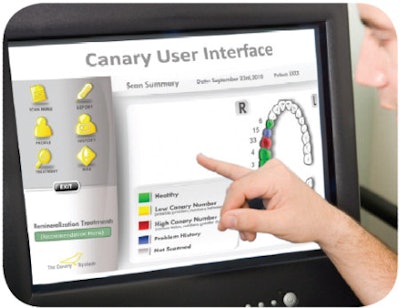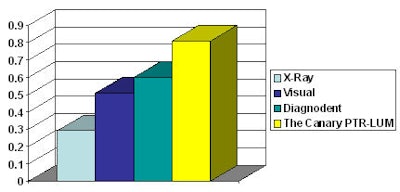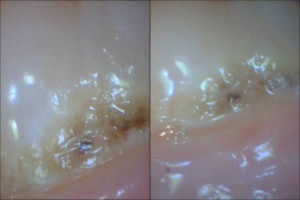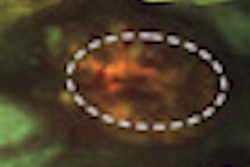
Two years after unveiling a prototype of the Canary dental caries detection system at the International Association for Dental Research (IADR) conference in Toronto, Quantum Dental Technologies is returning to the IADR meeting -- this time in Barcelona, Spain -- to present some of its first clinical findings.
The company has been busy enhancing the initial design of the product over the last two years and testing it out on patients in a clinical setting, said Stephen Abrams, D.D.S., CEO of Quantum. The device now uses a simple red, yellow, and green approach; a single corresponding "Canary Number" for each tooth; and a voice prompt to help the patient quickly assess where problem areas are and track their progress over time.
 |
| The Canary reports are displayed on an interactive, touchscreen monitor for immediate chairside review. All images courtesy of Quantum Dental Technologies. |
"What is truly exciting is the software we are developing and how it acts to engage the patient in their oral care," he said. "Our system has a built-in voice prompt which provides the operator and the patient with the Canary reading after each area is scanned."
Scanning involves first capturing an image of the surface to be examined, then having the operator scan the surface, gathering data every five seconds from various spots on the tooth. For example, a brown spot on the buccal surface of a tooth could be examined in detail in about 50 seconds as the operator moves around the area, Dr. Abrams explained.
"Patients very quickly become attuned to the numbers and begin to ask what they mean and where the area is," he said. "In our clinical trials, we are using this opportunity to show the patient the area of concern and show them how we can develop a remineralization program built around the Canary and a variety of agents, [including] office fluoride varnish, home-based toothpastes, and home-based CCP-ACP gels."
While each of these agents can remineralize lesions, until now there has not been a device that can monitor changes and allow the dentist to change therapies while the lesion is small, Dr. Abrams added. The final version of the Canary system will have both on-screen and printed reports available for the dentist and the patient.
Early clinical findings
The supporting clinical research so far is fairly slim, however, and there have been no published clinical studies. But the company does claim more than 30 published studies on the photothermal radiometry and modulated luminescence (PTR-LUM) technique, including a comparison of PTR-LUM and conventional diagnostic methods, including visual inspection, radiographs, and the Diagnodent (Caries Research, November-December 2004, Vol. 38:6, pp. 497-513).
Among other findings, that study concluded that, using the combined criteria of four PTR and LUM signals (two amplitudes and two phases), "the sensitivity of this method was much higher than any of the other methods used in this study, whereas the specificity was comparable to that of dc luminescence diagnostics [the Diagnodent]."
A more recent study in the Journal of Physics (2010, Conference Series 214) noted that "A combination of PTR and LUM has been developed into an analytical caries detection tool of combined specificity and sensitivity, substantially better than the Diagnodent, radiographic, and visual methodologies."
 |
|
In a 2004 study comparing PTR-LUM with conventional diagnostic methods, PTR-LUM had the highest sensitivity for detecting pit-and-fissure caries. |
In terms of clinical research, so far the Canary has been tested on 75 patients, 50 in an initial clinical trial that concluded in December 2009 and 25 to date in a second trial that just got under way, Dr. Abrams said.
The aim of the first trial was to demonstrate that the device is safe and can distinguish between healthy and carious enamel, he noted. In the study, clinicians used the original Canary prototype to measure PTR and LUM amplitude and phase responses at various modulation frequencies from healthy and carious teeth. More than 500 regions on healthy teeth were probed to construct a baseline for each output channel. PTR was used to detect near-surface and subsurface lesions, while LUM was used to detect near-surface lesions.
 |
| The Canary system was used to noninvasively detect a 2 x 4-mm lesion along the gum line with difficult visual access (left). Initial PTR reading was 36.1 and initial LUM reading was 2.1. Following three months of remineralization treatment, PTR had dropped to 16.2 and LUM had increased to 2.8, indicating a decrease in the presence of decay (right). |
The Canary did not cause any adverse events or soft- or hard-tissue trauma, according to the researchers. They found little or no difference in signal from wet or dry tooth surfaces, which means there is no need to isolate the teeth, they added. "Results from this first clinical trial showed that the Canary is safe and discriminates between healthy and carious enamel with little or no tooth preparation," the researchers noted.
In addition, anterior and posterior healthy tooth surfaces provided the same signal, and the presence of surface stain or biofilm did not affect the signal from healthy tooth surfaces.
"In selected carious lesions, we observed a shift from the baseline in PTR, LUM, or both signals depending upon the type, depth, and nature of the lesion," the researchers noted. PTR amplitude increased up 6% to 230%, PTR phase shifted up 5% to 25%, LUM amplitude decreased 7% to 85%, and LUM phase shifted up 1% to 9%.
"What this is means is that if there is an area of decay, it will absorb and radiate back in the infrared," Dr. Abrams said. "So as an area of decay decreases, there is less of it to absorb the laser energy and radiate back. With the LUM increase, it means you are getting back much healthier tooth surface."
How it works
Using frequency-domain photothermal radiometry (PTR) and modulated luminescence technology (LUM) developed at the University of Toronto, the Canary caries detection system scans each tooth with low-power diode laser energy. The system measures both the luminescence and the heat released from the tooth to identify the extent of decay.
A digital readout and corresponding voice prompt indicates the status of a particular area of the tooth. The temperature rise on the teeth and in the pulp is not more than 1° Celsius, according to Quantum Dental Technologies, which is commercializing this device.
By varying the pulse of the laser, dentists can identify decay as deep as 5 mm from the tooth surface and as small as 50 microns in size, according to Quantum. As a lesion grows, there is a corresponding change in the signal; a signal reversal indicates that the remineralization process has started.
Commercial launch
The aim of the second trial, which was initiated in April 2010 and is being conducted at three dental office sites in the Toronto area, is to establish how the Canary detects and monitors tooth decay in vivo in dental practice situations, and to monitor and quantify changes in detected lesions treated with remineralization therapies. Quantum expects to ultimately obtain data from 150 patients during this trial, and some of that data will be presented at the IADR meeting along with results from the first clinical trial, Dr. Abrams said.
In the meantime, working in conjunction with Institut National d'Optique, Canada's largest center for industrial optics and photonics, the company is developing a commercial version of the Canary that it plans to debut at the IADR meeting, along with a hands-on workshop for attendees to test it out. Quantum expects to launch the device commercially in November of this year, pending regulatory clearances in Canada and the U.S., according to Dr. Abrams.
Copyright © 2010 DrBicuspid.com



















